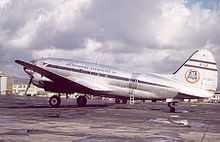1951 Miami Airlines C-46 crash

A C-46F similar to the accident aircraft
|
|
| Accident summary | |
|---|---|
| Date | 16 December 1951 |
| Summary | In-flight engine fire |
| Site | Elizabeth, New Jersey, United States |
| Passengers | 52 |
| Crew | 4 |
| Fatalities | 56 (all) |
| Survivors | 0 |
| Aircraft type | Curtiss C-46F-1-CU Commando |
| Operator | Miami Airlines |
| Registration | N1678M |
| Flight origin | Newark Airport, New Jersey |
| Destination | Tampa International Airport, Florida |
On 16 December 1951, a Miami Airlines Curtiss C-46 Commando airliner crashed in the town of Elizabeth, New Jersey, shortly after taking off from nearby Newark Airport. All 56 people on board were killed. At the time, it was the second-deadliest aviation accident on US soil, behind Northwest Orient Airlines Flight 2501.
The aircraft involved in the accident, registered N1678M, was a Curtiss C-46F-1-CU Commando military aircraft that had been converted into a commercial airliner. It had first flown in 1945 and had logged a total of 4,138 flight hours during its career. It was powered by two Pratt & Whitney R-2800-51 Double Wasp engines. The aircraft's occupants on the accident flight consisted of 52 passengers and six crew, including the captain, C. A. Lyons of Miami, and Doris Ruby, a popular nightclub entertainer from Sunnyside, Queens.
The Miami Airlines C-46 was preparing for a scheduled non-stop passenger flight from Newark to Tampa. Of the aircraft's two engines, the right engine took longer to start up; ominously, people nearby could see smoke continuously coming from that engine. At around 15:00 PM EST, the flight taxied out to runway 28, and was cleared for takeoff at 3:03. Just after takeoff, however, Newark ATC personnel saw a trail of white smoke coming from the right side of the aircraft. The tower controller, concerned about the danger of there being a fire, pressed the airport crash alarm button. A Miami Airlines employee observing the takeoff from the ground also saw the smoke, which he believed was due to an overheated right brake. The captain telephoned the control tower and warned for the aircraft to keep its landing gear down or, if it had already been raised, to extend it. The tower relayed the captain's warning to the flight crew of the C-46, who acknowledged and started the process of lowering the landing gear.
The aircraft continued ahead in the direction it took off in for a distance of about four miles, slowly gaining an altitude of approximately 800 to 1,000 feet. All throughout, the smoke progressively worsened; by the time the aircraft had reached the four-mile point, black smoke and actual flames could be seen trailing from the underside of the right engine nacelle. Shortly after the landing gear was lowered, a large burst of flames erupted from underneath the right nacelle. The aircraft banked left to an angle of about 10 degrees and continued onwards in this position for another 4.5 miles, gradually losing altitude as it went.
...
Wikipedia
